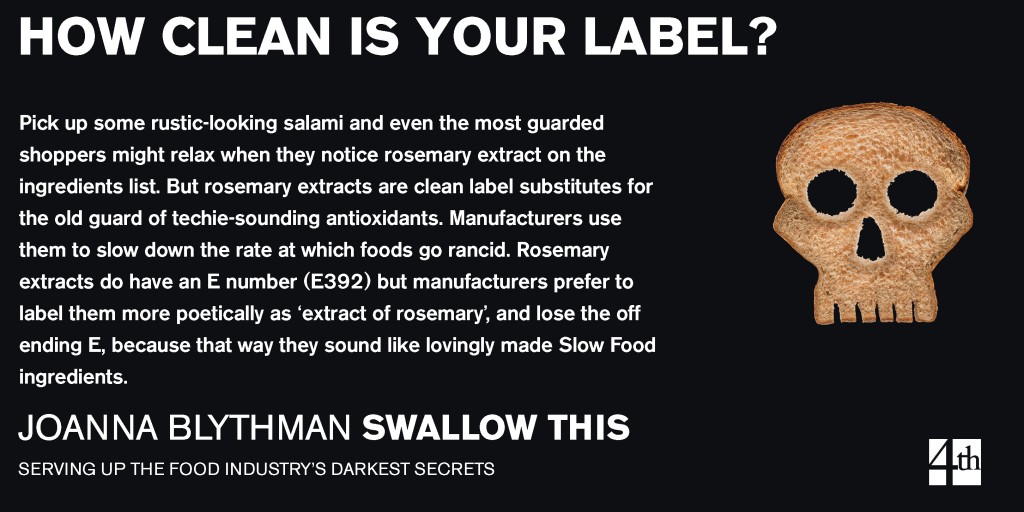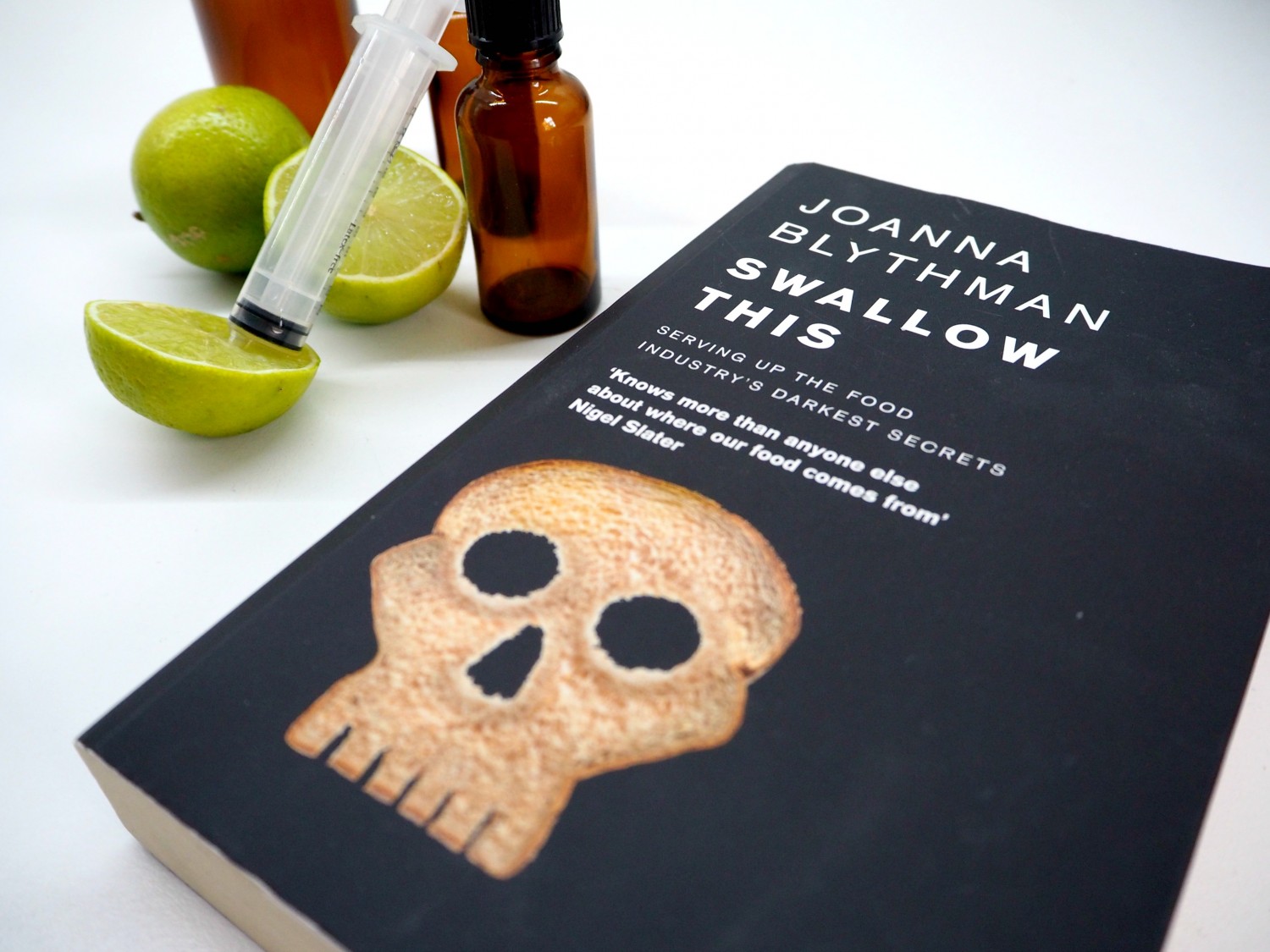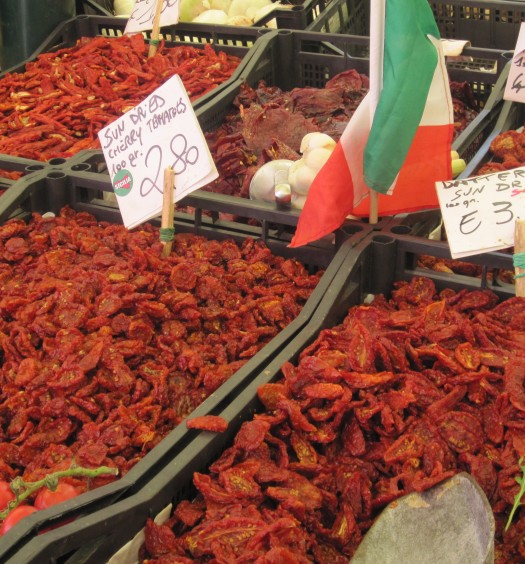We’ve been lucky enough to have an interview with investigative food journalist Joanna Blythman. I have to say that her book Swallow This: Serving Up the Food Industry’s Darkest Secrets is a real eye opener. It’s compelling, emotive, shocking and a must-read for anyone who cares about the food they eat and where it came from.
Joanna Blythman went undercover to find out just how our food is made and how manufacturers will use every possible trick to dupe us with their ‘clean’ labels to maximize profits with an entire disregard for our health. And it’s not just the obvious highly processed foods that come under scrutiny. In the book she discloses how the industry uses antifreeze and varnish to keep their cooking oil ‘fresh’ and chemicals on chopped fruit to extend shelf life. These ‘not on the label’ practices will leave you reeling.
 What inspired you to write your latest book Swallow This and were you faced with much resistance from the food industry?
What inspired you to write your latest book Swallow This and were you faced with much resistance from the food industry?
I felt that we knew a certain amount about the primary production of food, that is, what happens on the farm, in the field, but almost nothing about the secondary production, what happens in food factories that process raw ingredients into edible products. In other words, we have a fair idea of how our chickens are reared, but little concept of how chicken is made into a Kiev or sandwich filling. Many people now eat more and more processed food than ever before, so we need to be better informed about how it is produced.
Of course, manufacturers have to list ingredients on the label, but this tells us surprisingly little. For instance, was the “onion” used in your lasagna peeled and prepared fresh, or was it bought-in pre-chopped and frozen? Things like this make a big difference to the taste. Labels also don’t cover the use of “processing aids”, behind-the-scenes use of technologies, such as enzymes, often employed as short cuts to give foods and drinks certain characteristics (such as, make bread look golden, more voluminous) and so on.
Food manufacturers are notoriously secretive. They don’t do “open doors” days. I did manage to get into some food factories by calling in favours and giving assurances that the factory would not be identified, but for most information I had to assume a false identity and pose as a food manufacturer in order to get access to critical information.
Most UK manufacturers have now phased out artificial colours and flavours but should we be worried about the ‘natural’ ones being used instead?
To my mind, there is no real qualitative difference between artificial and “natural” colours. The source material for the latter must be natural, but thereafter, all the high tech techniques used to manufacture them can be very similar to those used to produce artificial colours. Basically, whether synthetic or “natural”, colourings are all about conning us. Even the UK Food Standards Agency admits that factory foods “would be grey or colourless if colour was not added to them during the manufacturing process”. The point here is that the high temperatures, pressure, and stress of manufacturing strip ingredients of their naturally attractive colours and if we saw them like this, we wouldn’t want to eat it. Colourings make factory food look appetizing when otherwise it wouldn’t. “Extracts” are often just “clean label” swops for additives.
Why is it that when I chop fresh fruit or vegetables they start to degrade soon after yet when I buy pre-cut ‘fresh’ ingredients they seem to last longer. Are they actually fresh?
Fruits and vegetables naturally start to change colour, lose vitality and degrade when you handle them. This is why washed carrots, for example, keep less well than unwashed ones. The technical term here is “wounded tissue”. Food processors make a lot of profit from labour-saving, pre-prepared fruits and vegetables; this is a very good way to “add value” to products. Of course, if prepared fruits and vegetables was just left without any treatments it would show its age so processors use a number of behind-the-scenes technologies to keep them looking fresh for longer, or give them what they refer to as “a fresh-like quality”. These treatments include “washing” them in water and bleach, dipping them in a bath of fruit acids and sometimes enzymes, then packing them in puffy bags flushed with “modified air” where all the oxygen has been removed. Produce processed this way often looks good when you buy it, but then when you unpack it at home, it flops spectacularly.
If you have ever eaten one of those utterly tasteless fruit salads on a plane, it’s most likely that the contents had this sort of treatment to prolong their shelf life.
It’s not always logistically or financially possible to buy everything organic. What are your top five organic ‘must haves’ and why?
Flour (it’s cheap), milk, yogurt and eggs (better animal welfare), citrus fruits (to avoid the fungicides and cosmetic waxes on the skin when you plan to use the zest).
In your opinion, what are the worst offenders on the supermarket shelves?
That depends on what your main concern is, but in terms of additives and processing aids, bread and baked goods are some of the worst. Ready sauces and condiments are often full of junk. For example, one slimmer’s mayonnaise I know contains 20 ingredients! Cheap meat is a usual suspect, often stuck together with “meat glue”, gums, and water. Definitely to be avoided. My advice to people is to shop as much as possible for ingredients, not manufactured food products. Obviously some simple, lightly processed foods, such as butter, are fine, but I steer away from more complex processed products with multiple ingredients.
There has been an explosion in gluten-free breads. You have expressed concern about the junk that goes into these – what should people be checking for on the labels?
The big-selling gluten-free ranges are lucrative havens for all the additives that progressive food manufacturers now try to avoid, chemicals such as E464 hydroxypropyl methyl cellulose, which is made from treated sawdust and also used in cement and eye drops, and E415 xanthan gum, a substance designed for soaking up oil spills from fracking. To my mind, most commercial gluten-free ranges are a big con, an excuse to charge a 500% premium for the worst sort of industrial ingredients and additives.
There are some small companies making good gluten-free options, such as Artisan Bread Organic. As with all processed foods, avoid gluten-free products that include ingredients that you don’t have at home or if you don’t really understand what they are. Your gut reaction of suspicion is probably correct!
Apart from avoiding supermarkets altogether, what advice would you give for choosing the least tampered with foods?
I have actually written a whole book about how to do this – What To Eat: Food that’s good for your health, pocket and plate. There are different considerations with different categories of food. Excuse me for promoting my book, but people tell me that it is terribly useful in this respect.
Are there any key trends happening at the moment in the food industry that consumers should be aware of?
Processed food manufacturers are on a “clean label” mission. They know that many of us are put off products when we see E numbers, or long, unfathomable chemical sounding names, such as carboxymethylcellulose, or mono-and diglycerides of fatty acids, in the ingredients listing. In food industry speak, such additives are “label polluters”. The essence of the “clean label” approach is to remove any ingredients or additives that worry us, and replace them with more natural-sounding alternatives. This is why the ingredients in processed foods now often come over as a lot more real and natural than they once did.
Some companies have used “clean label” to remove ingredients and additives that raised health concerns. But manufacturers still need these new “clean label” substitutes to be “functional”, that is, to perform all the same tasks as the old “dirty label” ones: flavouring, colouring, preserving, emulsifying, and so on. This means that many wholesome-sounding ingredients in processed foods and drinks these days are a lot less natural than we might like to think. For instance, rosemary extract (common in charcuterie and fresh pasta) doesn’t taste or smell of the herb at all but acts as a clean label antioxidant, essentially a preservative that extends shelf life. The same applies to black radish extract – it’s a shelf-life extender. Roasted barley malt extract is a colouring. Carrot and beetroot concentrates have no nutritional value and are just used as colourings.
Joanna Blythman is the author of Swallow This: Serving Up the Food Industry’s Darkest Secrets (Fourth Estate £14.99) and What To Eat: Food that’s good for your health, pocket and plate. (Fourth Estate £8.99)
To find quick, easy and nutritious recipes using natural ingredients that haven’t been tampered with and for more articles on health and nutrition sign up to our newsletter to receive a monthly round up of our latest posts and much more.






